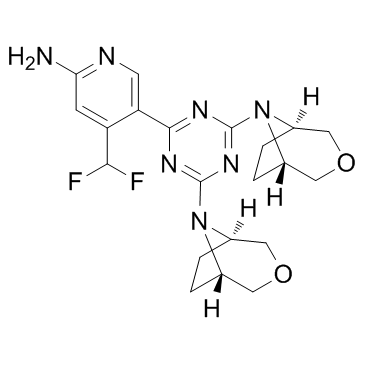| Description: |
PQR620 is a novel potent and selective brain penetrant inhibitor of mTORC1/2. |
| Target: |
mTORC1
mTORC2 |
| In Vivo: |
The physico-chemical properties of PQR620 result in good oral bioavailability and excellent brain penetration[1]. The activity of PQR620 as single agent undergoes in vivo evaluation in two DLBCL models, the germinal center B cell type DLBCL (GCB-DLBCL) SU-DHL-6 and the acivated B cell-like DLBCL (ABC-DLBCL) RIVA. Treatments with PQR620 (100 mg/kg dose per day, Qd×7/w) start with 100-150 mm3 tumors and are carried for 14 (SU-DHL-6) or 21 days (RIVA). In both models, PQR620 determines a 2-fold decrease of the tumor volumes in comparison with control, with significant differences in both SU-DHL-6 (D7, D9, D11, D14; P<0.005) and RIVA (D14, D16, D19, D21; P<0.005)[2]. |
| In Vitro: |
PQR620 is a potent and selective mTOR inhibitor, which induces >1000-fold selectivity towards mTOR over PI3Kα in enzymatic binding assays. In A2058 melanoma cells PQR620 demonstrates inhibition of protein kinase B (pSer473) and ribosomal protein S6 (pSer235/236) phosphorylation with IC50 values of 0.2 μM and 0.1 μM, respectively. PQR620 shows excellent selectivity over a wide panel of kinases, as well as excellent selectivity versus unrelated receptor enzymes and ion channels. PQR620 demonstrates its potency to prevent cancer cell growth in an NTRC 44 cancer cell line panel, resulting in a 10log(IC50) of 2.86 (nM)[1]. PQR620 has a median IC50 of 250 nM when tested on 44 lymphoma cell lines. Activity is higher in B cell than in T cell tumors (median IC50s: 250 nM vs 450 nM; P=0.002). At 72h, anti-tumor activityof PQR620 is mostly cytostatic and apoptosis induction is seen only in 6/44 cell lines (13%). Sensitivity to PQR620 or apoptosis induction does not differ between DLBCL and MCL, and they are not affected by the DLBCL cell of origin, by TP53 status or by the presence of MYC or BCL2 translocations[2]. |
| Cell Assay: |
The drug concentration causing 50% inhibition of cell proliferation (IC50) is obtained in lymphoma cell lines [diffuse large B cell lymphoma (DLBCL); mantle cell lymphoma (MCL); anaplastic large T-cell lymphoma; and others] exposed to increasing doses of PQR620 for 72 h using a Tecan D300e Digital Dispenser on 384 well plates[2]. |
| Animal Administration: |
Mice[2] For in vivo experiments, NOD-Scid (NOD.CB17-Prkdcscid/J) mice are subcutaneously inoculated with 10×106 (RIVA) or with 5×106(SU-DHL-6) cells. Treatments with PQR620 (100mg/kg dose per day, Qdx7/w) started with 100-150 mm3 tumors and are carried for 14 (SU-DHL-6) or 21 days (RIVA). |
| References: |
[1]. Florent Beaufils, et al. Abstract 1336: Structure-activity relationship studies, synthesis, and biological evaluation of PQR620, a highly potent and selective mTORC1/2 inhibitor. Cancer Research; 2016 Apr 16-20.
[2]. Chiara Tarantelli, et al. Targeting the PI3K/mTOR Pathway in Lymphoma with PQR309 and PQR620: Single Agent Activity and Synergism with the BCL2 Inhibitor Venetoclax. Blood 2016 128:3017. |






















